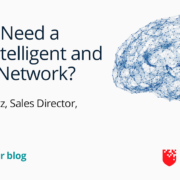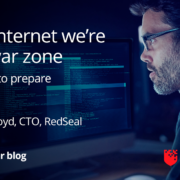Do You Need a More Intelligent and Secure Network?
By the third quarter of 2021, the number of recorded network breaches already exceeded the total breach volume of 2020 by 17 percent. What’s more, the total cost of breaches continued to rise. Data from IBM and the Ponemon Institute found that the average cost of a data breach topped $4.24 million in 2021, the highest this value has been in nearly two decades.
What does this mean? Businesses need better ways to react and respond to network security vulnerabilities. While this starts with basic security measures to mitigate the impact of issues as they occur, it also requires the creation of more intelligent networks capable of proactively detecting, identifying, and responding to threats.
Why Security Should Be a Top Priority for Every Organization
Effective security tools are now table stakes for organizations to ensure they meet evolving legislative standards around due diligence and data control. But these straightforward security measures aren’t enough to address the evolving nature of information technology (IT) environments — from rapid cloud adoption to mobile-first environments to the update of edge computing. The sheer volume and variety of corporate IT environments create organizations’ ever-changing challenges.
Increasing complexity also plays a role in security. Driven by the rapid shift to remote work and underpinned by the unstable nature of return-to-work plans, security teams now face the challenge of distributed and decentralized security environments which naturally frustrate efforts to create consistent security policies.
Consider some of the biggest data breaches of recent years:
- Android: 100 million records exposed. In May 2021, the records of more than 100 million Android users were exposed as a result of cloud misconfigurations. Personal information, including names, email addresses, dates of birth, location data, payment information, and passwords, were available to anyone who knew where to look.
- Facebook, 553 million records exposed. Facebook records of more than 553 million users from 106 countries were leaked online. Leaked data included phone numbers and email addresses, which according to security researcher Alon Gal, “would certainly lead to bad actors taking advantage of the data to perform social-engineering attacks [or] hacking attempts.”
- LinkedIn, 700 million records exposed. Over 90 percent of LinkedIn members had their data compromised when it appeared for sale online. Information up for grabs included full names, phone numbers, physical addresses, email addresses, and details of linked social media accounts and user names.
Enterprises aren’t the only target for cybercriminals. As noted by Forbes, 43 percent of all cyberattack victims are small and midsize businesses (SMBs). While breaching a large enterprise can be a multimillion-dollar jackpot, SMBs are often easier targets that offer quick gains.
As a result, robust security must be a priority for every organization, regardless of size or industry.
Why Intelligence Matters for Effective Network Defense
While security is a solid starting point, it’s not enough in isolation. To handle evolving threats, companies need intelligent frameworks capable of identifying critical assets, pinpointing key vulnerabilities, and prioritizing security response. This intelligence-led approach is essential to defend IT environments now underpinned by interconnected devices, multiple cloud frameworks, and expanding edge services.
Consider that 92 percent of companies now leverage a multi-cloud approach to maximize efficiency and drive return on investment (ROI). Using multiple clouds offers a way for companies to pinpoint — and pay for — the specific solutions and services they need to achieve business aims. However, ensuring security across multiple cloud touch points rapidly becomes complex, especially as these clouds share and modify data in real-time.
What’s the best-case scenario during an attack? Compromise in one cloud hampers the efficacy of others but poses no substantive risk. And the worst case? Attacks on primary cloud services lead to successive service failures and significant downtime.
To address the challenges of expanding IT environments, companies must take an intelligence-led security approach. In practice, this means deploying tools capable of autonomous action to help detect and report IT threats, combined with robust data collection and analysis to help pinpoint root causes, rather than simply solving for symptoms.
How to Increase Your Network Intelligence and Security
While there’s no one-size-fits-all approach to increasing network intelligence and security, four functional approaches can help reduce total risk and boost your protective potential.
- Comprehensive Cloud Asset Identification: As cloud environments become more complex, the risk of asset blind spots that allow malicious actors to infiltrate networks without detection increases. Robust asset identification across all cloud services — from private clouds to public services such as AWS, Azure, and Google — is critical to limit overall risk.
- Complete Network Visualization and Access Management: Sight drives better security. If you can see what’s on your network and how it all connects, you can better identify where potential threats may occur. As a result, companies must deploy tools that offer complete visibility across all network environments and provide robust access control to ensure the right people have access to the right resources.
- Consistent Network Compliance: Today’s organizations must follow standards such as the Payment Card Industry Data Security Standard (PCI DSS) and cybersecurity maturity model certification, along with legislation including the General Data Protection Regulation (GPDR) and California Consumer Privacy Act (CCPA). Adhering to these standards and mandates is essential to demonstrate due diligence and protect your organization against penalties or legal action if security breaches do occur.
- Critical Vulnerability Prioritization: The scope and scale of new attack vectors make security triage a priority. End-to-end assessment of potential network risks based on exposure and access can help your teams prioritize vulnerabilities and design effective response frameworks.
Closing the Security Gap
No matter your business size, specialization, or industry, you need a more secure and intelligent network. Informed by increasingly complex IT environments and driven by evolving attack vectors, malicious actors are finding — and exploiting — new ways to compromise critical functions. Intelligent response is now critical to increase user confidence, and you must capture key data and protect your network.
RedSeal can help you close the security gap with an adaptable and intelligent approach to network security. From cloud security frameworks to robust network compliance solutions, access and visibility tools, and critical vulnerability prioritization, we have the technology tools and expertise to help your team build a reliable and responsive security framework.
Increase intelligence, navigate network security challenges and reduce real-life risks with RedSeal. Let’s get started.



